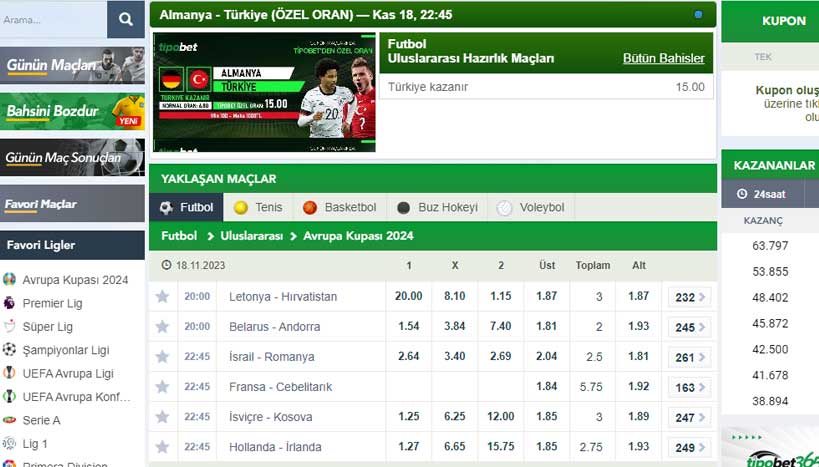Tipobet, dünya çapında tanınan ve tercih edilen bir online bahis platformudur. Kendine has özellikleri, geniş oyun yelpazesi ve güvenilirliği ile bahis severlerin bir numaralı tercihi olmuştur. Bu yazıda, Tipobet hakkında bilmeniz gerekenleri ve site içerisinde nasıl navige edileceği konusunda bir bakış açısı elde edeceksiniz.

Tipobet, üyelerine çeşitli bahis seçenekleri sunan bir internet platformu olmasının yanı sıra, aynı zamanda çeşitli casino oyunları, poker ve daha pek çok eğlenceli oyunu ile üyelerine eşsiz bir deneyim sunar. Spor bahisleri, canlı bahis, sanal sporlar gibi seçenekler, bu platformun ana odak noktalarıdır.
- Spor Bahisleri: Futbol, basketbol, tenis, hentbol, beyzbol, Amerikan futbolu ve daha birçok spor dalına ait maçlarda bahis yapabilirsiniz. Her bir maç için detaylı istatistikler ve canlı skor bilgileri sunulmaktadır. Bu sayede bahis severler daha bilinçli bahisler yapabilirler.
- Canlı Bahis: Canlı bahisler, maç esnasında bahis yapma imkanı sunar. Maç esnasında değişen oranlar ve bahis seçenekleri, bahis severlere heyecanlı ve dinamik bir bahis deneyimi yaşatır.
- Sanal Sporlar: Sanal sporlar, bilgisayar tarafından kontrol edilen ve her an bahis yapabileceğiniz bir seçenektir. Futbol, at yarışı ve tazı yarışı gibi seçenekler mevcuttur.
- Casino Oyunları: Canlı casino oyun seçenekleri, slot, poker, blackjack, rulet ve tüm diğer casino oyunları, Tipobet’in casino oyunları arasında yer alır. Her bir oyun gerçekçi grafikler ve ses efektleri ile üyelere gerçek casino deneyimi sunar.

Tipobet’in tekil özelliklerinden bir diğeri de sağladığı bonuslardır. Üyelerine çeşitli bonuslar ve promosyonlar sunarak, bahis deneyimlerini daha karlı ve heyecanlı bir hale dönüştürür. Hoşgeldin bonusu, yatırım bonusları, kayıp bonusları ve daha pek çok bonus seçeneği mevcuttur.
Son olarak, Tipobet güvenilir bir bahis platformudur. Lisanslı bir platform olan Tipobet, kullanıcılarına güvenli ve adil bir bahis ortamı sunar. Kullanıcıların kişisel bilgileri ve finansal işlemleri, son teknoloji şifreleme sistemleri ile korunmaktadır.
Tipobet hakkında daha detaylı bilgi almak ve üye olmak için Tipobet sitesini ziyaret edebilirsiniz. Şansınızı deneyin ve kazançlı çıkın!
Tipobet Giriş

Çevrimiçi bahis dünyası her geçen gün büyüyor ve bu büyümeyle birlikte değişiklikler ve yenilikler geliyor. Türkiye’deki online bahis severlerin sıklıkla tercih ettiği platformlardan biri olan Tipobet, bu değişim ve gelişimlerden nasibini alıyor ve kullanıcılarına en iyi hizmeti vermeyi amaçlıyor. Ancak bu sektörde özellikle Türkiye’den ulaşmak bazen biraz sıkıntılı olabiliyor. İşte tam da bu yüzden Tipobet giriş adresi hakkında bilgi sahibi olmak oldukça önemli.
Tipobet giriş adresi, sitenin Türkiye’deki kullanıcılarına hizmet verdiği platformun URL’sidir. Bu adres zaman zaman BTK tarafından engellendiği için değişir ve Tipobet, kullanıcılarına kesintisiz hizmet vermek için yeni bir adres üzerinden hizmetine devam eder. Bu yazıda, Tipobet’in güncel giriş adresi hakkında bilmeniz gereken her şeyi ele alacağız.
Tipobet Giriş Adresi Neden Değişiyor?
Türkiye’deki online bahis sektörü, devlet tarafından özel bir düzenlemeye tabi. Yani, bu tür sitelere erişim çoğunlukla engellendiğinden, siteler Türkiye’deki kullanıcılarına hizmet vermek için adreslerini güncellemek zorunda kalıyor. Tipobet’in giriş adresi de bu sebeplerden dolayı sık sık değişiyor. Ancak bu durum sitenin güvenilirliğini ya da hizmetlerinin kalitesini etkilemiyor. Tipobet, tüm bu değişikliklere rağmen kullanıcılarına kaliteli ve güvenilir bir bahis deneyimi sunmayı hedefliyor.
Tipobet’in Güncel Giriş Adresini Nasıl Bulabilirim?
Tipobet’in güncel giriş adresini bulmanın birçok yolu var. İlk olarak, resmi sosyal medya hesaplarını takip edebilirsiniz. Tipobet, Twitter ve Facebook gibi platformlarda aktif olup, güncel giriş adresini bu hesaplar üzerinden duyurur. Diğer bir yol da bahis forumları ya da bahis haber siteleridir. Bu platformlarda Tipobet’in güncel giriş adresini bulabilirsiniz. Son olarak, Tipobet’e üye olduğunuzda, site sizi e-posta yoluyla yeni giriş adresi hakkında bilgilendirir.
- Resmi Sosyal Medya Hesapları: Tipobet’in Twitter ve Facebook hesaplarını takip ederek, güncel giriş adreslerini öğrenebilirsiniz.
- Bahis Forumları ve Haber Siteleri: Çeşitli bahis forumları ve haber siteleri, genellikle Tipobet’in güncel giriş adresini paylaşır. Bu siteleri takip ederek, yeni giriş adreslerini hızlıca öğrenebilirsiniz.
- E-posta Bildirimleri: Tipobet üyelerine, sitenin yeni giriş adresi hakkında e-posta bildirimleri gönderir. Bu sebeple, Tipobet’e üye olurken verdiğiniz e-posta adresinin aktif ve sizin erişiminize açık olduğundan emin olun.
Sonuç olarak; Tipobet giriş adresi hakkında bilgi sahibi olmak, Tipobet’in sunduğu kaliteli, güvenilir ve eğlenceli bir bahis deneyiminden kesintisiz bir şekilde yararlanabilmeniz için önemlidir. Bu yüzden, yukarıda belirtilen yöntemlerden hangisini seçerseniz seçin, her zaman Tipobet’in güncel giriş adresini takip etmeye özen gösterin.
Tipobet’in Lisans Durumu

Tipobet, Curaçao Hükümeti tarafından verilen bir lisansa sahiptir. Curaçao lisansı, bir bahis sitesinin tüm faaliyetlerini resmi ve yasal bir çerçevede yürüttüğünü gösterir. Lisans numarası site üzerinde açık bir şekilde belirtilmiştir ve bu, siteye olan güveni artırır. Curaçao Gaming Authority tarafından düzenli olarak denetime tabi tutulur ve bu sayede kullanıcılarına adil ve güvenilir bir bahis ortamı sunulmaktadır.
- Lisans Numarası: Tipobet’in Curaçao lisans numarası 1668/JAZ’dir. Bu numara ile Curaçao Gaming Authority’nin resmi sitesi üzerinden lisansın geçerliliği kontrol edilebilir.
- Lisansın Geçerlilik Durumu: Lisans sürekli olarak yenilenir ve güncellenir. Bahis sitesi, lisansını kaybederse veya geçerliliğini yitirirse, buna dair bilgiler anında site üzerinde güncellenir.
- Lisansın Sağladığı Güvence: Lisansa sahip olmak, site içerisinde gerçekleşen tüm finansal işlemlerin, oyunların ve bahislerin denetim altında olduğunu gösterir. Bu da kullanıcıların güvenilir bir ortamda bahis yapmalarını sağlar.
Tipobet, lisansını herkese açık bir şekilde paylaşarak, güvenilirliğini ve şeffaflığını gösterir. Bu da kullanıcıların siteye olan güvenini arttırır ve daha rahat bir şekilde bahis yapmalarını sağlar.
Tipobet Para Yatırma ve Çekme Seçenekleri

Tipobet, online bahis ve casino oyunları dünyasının önde gelen isimlerinden biridir. Kullanıcı odaklı hizmet anlayışı, geniş oyun yelpazesi ve güvenilir ödeme seçenekleri ile ön plana çıkmaktadır. Bu yazımızda Tipobet’in sunduğu para yatırma ve çekme seçeneklerini detaylı bir şekilde inceleyeceğiz.
- Para Yatırma Seçenekleri:
Tipobet, kullanıcılarının hesaplarına kolay ve hızlı bir şekilde para yatırabilmeleri için birçok farklı seçenek sunmaktadır.
Banka havalesi, Kredi Kartı, QR Kod, Cepbank, Papara, Bitcoin ve Jeton Cüzdan gibi çok sayıda seçeneği kullanabilirsiniz. Hem Türk Lirası hem de diğer döviz cinslerinde işlem yapabilme imkanı bulunmaktadır. Yatırım limitleri ve işlem süreleri, seçilen para yatırma yöntemine bağlı olarak değişiklik gösterebilir.
- Para Çekme Seçenekleri:
Tipobet, kullanıcılarına kazançlarını güvenilir ve hızlı bir şekilde çekebilmeleri için çeşitli seçenekler sunar.
Para çekme işlemlerinizi Banka Havalesi, Ecopayz, Papara, Bitcoin, Jeton Cüzdan gibi yöntemlerle gerçekleştirebilirsiniz. Her yöntemin kendine özgü limitleri ve işlem süreleri bulunmaktadır.
Tipobet Ödeme İşlemleri Güvenilir Mi?

Tipobet, kullanıcılarına sunduğu para yatırma ve çekme seçenekleriyle, güvenli ve hızlı ödeme işlemleri gerçekleştirilmesine olanak sağlar. Bu platform, Curacao eGaming lisansına sahip olup, kullanıcılarının güvenliğini öncelik olarak kabul eder ve bu doğrultuda hizmet verir.
Kullanıcılara, ödeme işlemlerini gerçekleştirirken herhangi bir sorun yaşamamaları için 7/24 canlı destek hizmeti sunmaktadır. Bu sayede olası problemler hızlı ve efektif bir şekilde çözümlenebilir.
Özetle, Tipobet’in sunduğu para yatırma ve çekme seçenekleri, bahis severlerin ihtiyaçları ve beklentileri doğrultusunda şekillendirilmiştir. Güvenilir ve hızlı ödeme işlemleri için Tipobet’i tercih edebilirsiniz.
Sıkça Sorulan Sorular
Tipobet'e nasıl üye olabilirim?
Tipobet sitesine üye olmak oldukça kolaydır. Ana sayfada bulunan "Üye Ol" butonuna tıklamanız ve istenen kişisel bilgilerinizi girerek kaydınızı tamamlamanız gerekmektedir. Tüm bilgilerin doğruluğunu kontrol etmeli ve onaylamalısınız. Daha sonra email doğrulama adımlarını takip ederek üyeliğinizi aktive edebilirsiniz.
Tipobet hesabıma nasıl para yatırabilirim?
Tipobet platformuna para yatırmak için çeşitli yöntemler bulunmaktadır. Bunlardan biri banka havalesi olup, site üzerinden banka hesabı bilgilerini alarak işlemi gerçekleştirebilirsiniz. Diğer bir seçenek ise e-cüzdan yöntemiyle para yatırmaktır. Bu yöntemde çeşitli e-cüzdan platformlarından birini kullanarak ödeme gerçekleştirebilirsiniz.
Hesabımdan para çekme işlemi nasıl gerçekleşir?
Tipobet'ten para çekmek için öncelikle "Para Çekme" seçeneğini tıklamanız gerekir. Daha sonra karşınıza çıkan seçeneklerden birini seçerek çekim işlemi için talepte bulunabilirsiniz. Çekim talebiniz genellikle 24 saat içinde işleme alınır. Herhangi bir sorunla karşılaşırsanız müşteri hizmetleri ile iletişime geçebilirsiniz.
Tipobet hesabıma erişim sağlayamıyorum, ne yapmalıyım?
Hesabınıza erişim sağlayamadığınız durumlarda öncelikle kullanıcı adınızı ve şifrenizi kontrol etmeli, hala sorun varsa "şifremi unuttum" seçeneğini kullanmalısınız. Eğer bu adımlar da çözüm sağlamazsa, Tipobet müşteri hizmetleri ile iletişime geçip, durumu bildirebilirsiniz.
Tipobet hakkında güncel promosyonlar nereden öğrenebilirim?
Tipobet, kullanıcılarına çeşitli promosyonlar ve bonuslar sunmaktadır. Bu bonusları ve promosyonları öğrenmek için site üzerinde "Promosyonlar" sekmesini kontrol edebilirsiniz. Ayrıca, özel promosyonlar ve bonuslar için Tipobet'in email bildirimlerine abone olmanızı öneririz.